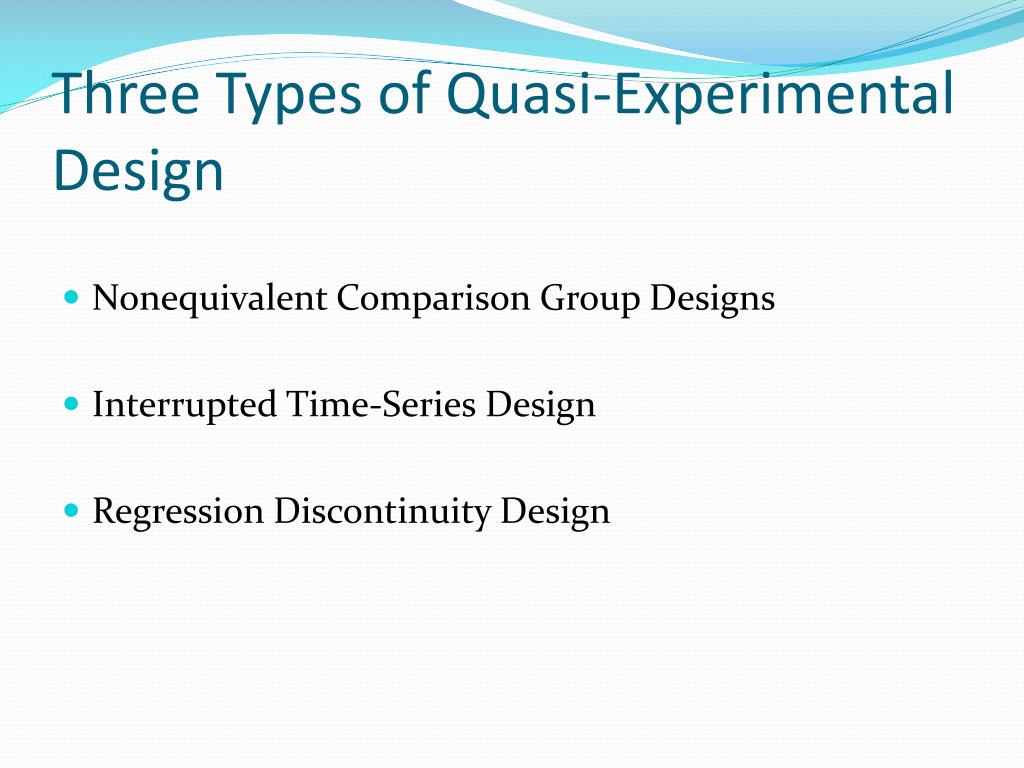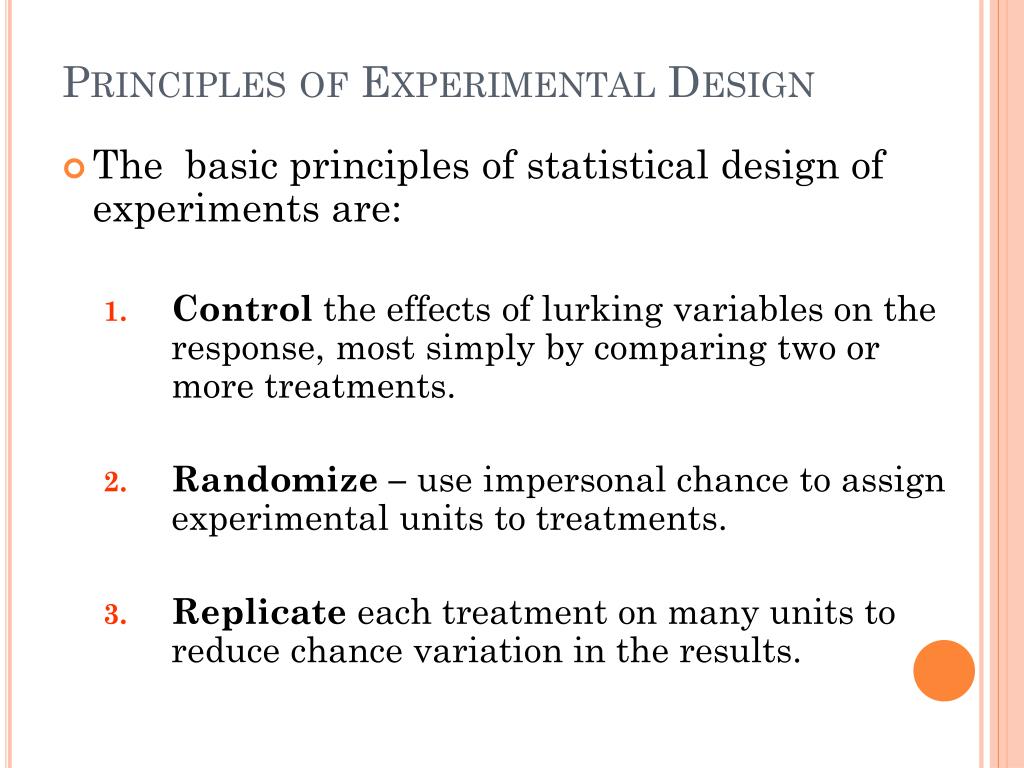Table Of Content

But there could be a third variable (Z) that influences (Y), and X might not be the true cause at all. The same is true for intervening variables (a variable in between the supposed cause (X) and the effect (Y)), and anteceding variables (a variable prior to the supposed cause (X) that is the true cause). When a third variable is involved and has not been controlled for, the relation is said to be a zero order relationship.
True Experimental Design

Imagine juggling not just one, but multiple balls in the air—that's what researchers do in a factorial design. This is when people like Francis Galton, an English polymath, started to get really systematic about experimentation. His work helped create the foundations for a more organized approach to experiments.
Design of complex neuroscience experiments using mixed-integer linear programming - ScienceDirect.com
Design of complex neuroscience experiments using mixed-integer linear programming.
Posted: Wed, 05 May 2021 07:00:00 GMT [source]
Quantitative Research – Methods, Types and...
Adaptive Designs are most often seen in clinical trials, particularly in the medical and pharmaceutical fields. This method is particularly useful in fast-paced or high-stakes situations, like developing a new vaccine in the middle of a pandemic. The ability to adapt can save both time and resources, and more importantly, it can save lives by getting effective treatments out faster. Let's say you're a teacher and you want to know if a new math program helps kids get better at multiplication. First, you'd give all the kids a multiplication test—that's your pretest.
Experimental and control groups
How design of experiments lowers costs in R&D - Scientific Computing World
How design of experiments lowers costs in R&D.
Posted: Wed, 29 Mar 2023 11:18:22 GMT [source]
Basically, a researcher can conduct experimental research any time they want to test a theory with variable and dependent controls. ANOVA is a statistical technique used to compare means across two or more groups in order to determine whether there are significant differences between the groups. There are several types of ANOVA, including one-way ANOVA, two-way ANOVA, and repeated measures ANOVA. Physiological measures involve measuring participants’ physiological responses, such as heart rate, blood pressure, or brain activity, using specialized equipment. These measures may be invasive or non-invasive, and may be administered in a laboratory or clinical setting. This design involves grouping participants within larger units, such as schools or households, and then randomly assigning these units to different treatment groups.
The study is carried out after some treatment which was presumed to cause change, making it a posttest study. Experimental research establishes a cause-effect relationship by testing a theory or hypothesis using experimental groups or control variables. In contrast, descriptive research describes a study or a topic by defining the variables under it and answering the questions related to the same.
The difference from 72 hours to 71 hours is not substantial enough to support that the observed effect was due to something other than normal random variation. These variables were not measured in the study but could influence smoking habits as well as mortality rates. The explanatory variable explains a response, similar to a child falling and skins their knee and starting to cry. So the explanatory variable is the fall, and the response variable is crying. The specific calculations you can do depend on the level of measurement of your variables.
Types of quantitative research designs
In pre-experimental research design, either a group or various dependent groups are observed for the effect of the application of an independent variable which is presumed to cause change. It is the simplest form of experimental research design and is treated with no control group. To study the how leading questions on the memories of eyewitnesses leads to retroactive inference, Loftus and Palmer (1974) conducted a simple experiment consistent with true experimental design. Some efficient designs for estimating several main effects were found independently and in near succession by Raj Chandra Bose and K. Kishen in 1940 at the Indian Statistical Institute, but remained little known until the Plackett–Burman designs were published in Biometrika in 1946.

For the sake of our lesson, and all future lessons, we will be using research methods where random sampling and experimental designs are used. Experimental design provides a structured approach to designing and conducting experiments, ensuring that the results are reliable and valid. The purpose of experimental design is to control and manipulate one or more independent variables to determine their effect on a dependent variable. Experimental design allows researchers to systematically investigate causal relationships between variables, and to establish cause-and-effect relationships between the independent and dependent variables.
When to use Experimental Research Design
A high-profile example of Mixed-Methods Design is research on climate change. Scientists use numbers and data to show temperature changes (quantitative), but they also interview people to understand how these changes are affecting communities (qualitative). You have to be skilled in different research methods and know how to combine them effectively. This approach is especially common in educational and community-based research, and it's been gaining traction since the late 20th century. The strong point of Repeated Measures Design is that it's super focused. Because it uses the same subjects, you don't have to worry about differences between groups messing up your results.
It also helps you consider things that might mess up your results, like outside influences you hadn't thought of. Well, in the world of research, experimental design is like the roadmap that helps you find those clues. It's like the game plan in sports or the blueprint when you're building a house. Just like you wouldn't start building without a good blueprint, researchers won't start their studies without a strong experimental design.
The two variable groups mirror the control groups, but researchers expose them to stimuli. The ability to differentiate between groups in multiple ways provides researchers with more testing approaches for data-based conclusions. Under completely experimental conditions, researchers expose participants in two or more randomized groups to different stimuli. Experimental research is an option when the project includes an independent variable and a desire to understand the relationship between cause and effect. When it's unethical or impractical to assign participants randomly, that’s when a quasi-experimental design comes in. This guide explores the types of experimental design, the steps in designing an experiment, and the advantages and limitations of experimental design.
Experimental research design provides researchers with a controlled environment to conduct experiments that evaluate cause and effect. A company in the product development phase creates multiple prototypes for testing. With a randomized selection, researchers introduce each test group to a different prototype. Develop a prediction about how the independent variable will affect the dependent variable.
A population can be made up of anything you want to study – plants, animals, organisations, texts, countries, etc. But this design can’t confirm a causal relationship between the two variables. Any change in test scores could have been influenced by many other variables, such as increased stress and health issues among students and teachers. Using the five steps to develop a research plan ensures you anticipate and eliminate external variables while answering life’s crucial questions. While experimental research might be the right choice for some studies, certain conditions could render experiments useless or even dangerous. Time series analysis is used to analyze data collected over time in order to identify trends, patterns, or changes in the data.
You should be able to create groups with an equal number of subjects and include subjects that match your target audience. Remember, you should assign one group as a control and use one or more groups to study the effects of variables. Define the independent variable (the intended stimuli) and the dependent variable (the expected effect of the stimuli). After identifying these groups, consider how you might control them in your experiment.
Next up is Sequential Design, the dynamic and flexible member of our experimental design family. In terms of applications, Stepped Wedge Designs are commonly used in public health initiatives, organizational changes in healthcare settings, and social policy trials. They are particularly useful in situations where an intervention is being rolled out gradually and it's important to understand its impacts at each stage. Let's now focus on the Stepped Wedge Design, a thoughtful and cautious member of the experimental design family. In traditional randomization, participants are allocated to different groups purely by chance.
In a traditional study, once you set your plan, you stick to it from start to finish. Well, sometimes it's just not practical to assign conditions at the individual level. For example, you can't really have half a school following a new reading program while the other half sticks with the old one; that would be way too confusing! Cluster Randomization helps get around this problem by treating each "cluster" as its own mini-experiment. A well-known example of Crossover Design is in studies that look at the effects of different types of diets—like low-carb vs. low-fat diets.

No comments:
Post a Comment